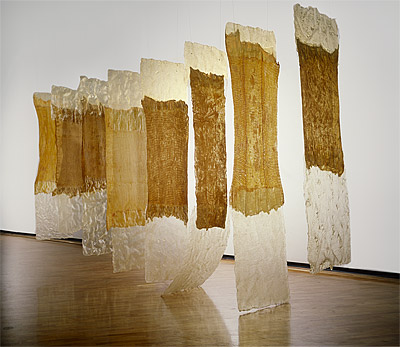Eva
HESSE
Germany
1936
–
United States of America
1970
United States of America from 1939
Contingent
1969
cheesecloth, latex, fibreglass
not signed, not dated
overall
350.0 (h)
x 630.0 (w)
x 109.0 (d)
cm
Purchased 1973
National Gallery of Australia, Canberra
NGA 1974.395.A-H
Courtesy the Estate of Eva Hesse, Galerie Hauser & Wirth, Zürich
Contingent is made of eight banner-like elements that hang from the ceiling. Each component is a large rectangular stretch of latex-covered cheesecloth embedded at each end in a translucent field of fibreglass. The units hang parallel to each other and at right angles to the wall. They appear as ‘skins lifted off the surface of a painting’, magically suspended in midair, a merging of light, colour, and gravity.[1] Contingent blurs the boundaries between painting and sculpture; it is, in the artist’s terminology, a ‘non-work’ which exists as a ‘hung painting in another material than painting.’[2] By virtue of its hybrid form, Contingent, more than any of Hesse’s other works, successfully synthesises the qualities of both disciplines.
Hesse began to experiment with latex in the late summer of 1967, and by 1968 was moving back and forth between it and her other favoured material, fibreglass. She was attracted to the neutral colour of latex, and its liquidity, finding it as responsive as paper-maché. Fibreglass, by contrast, is less yielding, and in combination the two substances create a distinct tension. Hesse plays off the light-absorbing and light-transmitting qualities of the two materials and in Contingent uses the heavier fibreglass attachments to pull taut the fragile latex midsections. This imparts a ‘palpable tension’, exaggerated by the ‘poignant contrast of the ephemeral and enduring qualities of the two materials.’[3] In several other large-scale works using latex, Hesse used an infrastructure of mesh or a backing of canvas, often pushing her materials to their limits.[4] She was well aware that latex decays―and loses the very qualities which she so valued―and knew of the discolouration and brittleness of fibreglass. Even though she admitted to feeling a little guilty that her works would not last, the qualities of latex were too appealing, seemingly irresistible.
Contingent is one of the last major works made by Hesse before her death in May 1970, aged 34. Although she had planned at least nine irregular sheets of rubberised cheesecloth and fibreglass, she and her assistants ran out of latex.[5] The individual differences between the banners pleased the artist, and she commented on the ‘divergency’ from one piece to the next, and the way in which they are geometric but not.[6] Hesse was working on Contingent when she collapsed in April 1969; she was admitted to New York Hospital and operated on for a brain tumour. The work’s title suggests its positioning between painting and sculpture, and the interdependence of the materials, but also the marshalling of forces, and their direction towards an event that is likely but not inevitable. The circumstances of its making, the inevitability of its decay, and a title which implies dynamism and uncertainty, all imbue Contingent with a strength which is implicit in the work, as well as an elegiac quality overlaid from the artist’s life.
Lucina Ward[7]
Curator,
International Painting and Sculpture
National Gallery of Australia, Canberra
[1]Bill Barrette, Eva Hesse: sculpture, Timken Publishers, New York, 1989, p 226
[2] For the artist’s statements see Lucy Lippard, in Eva Hesse, New York University Press, New York, 1976, p 131, and Cindy Nemser, Art talk: conversation with 12 women artists, Charles Scribner's Sons, New York, 1975, p 223, and republished as Art talk: conversation with 15 women artists, HarperCollins, New York, 1995, pp 194–95; extracts of Nemser's interview with Hesse―taped in three sessions early in 1970―were published in Artforum, May 1970, and the Feminist Art Journal, Winter 1973
[3]Bill Barrette, 1989, p 226
[4]For Aught 1968 (University of California, Berkeley) she made four rectangular envelope-like units of latex on canvas, and stuffed them with polyethylene sheeting, rope and other materials, including metal grommets. In the monumental Expanded expansion 1969 (Solomon R Guggenheim Museum, New York) she coated cheesecloth with rubber and used reinforced fibreglass poles for structure and to prop up the drapes. By the time of the chaotic, web-like Right after 1969 (Milwaukee Art Museum), made of resin cast over fibreglass cord and wire hooks, Hesse’s work was remarkable for its almost complete lack of structure and its ethereal qualities
[5]Bill Barrette, 1989, p 226. It is thought that Hesse would have selected from the panels
[6]Cindy Nemser, 1975 pp 220‑21
[7] See also Michael Lloyd and Michael Desmond, European and American paintings and sculptures 1870–1970 in the Australian National Gallery, Australian National Gallery, Canberra, 1992, pp 390–95

